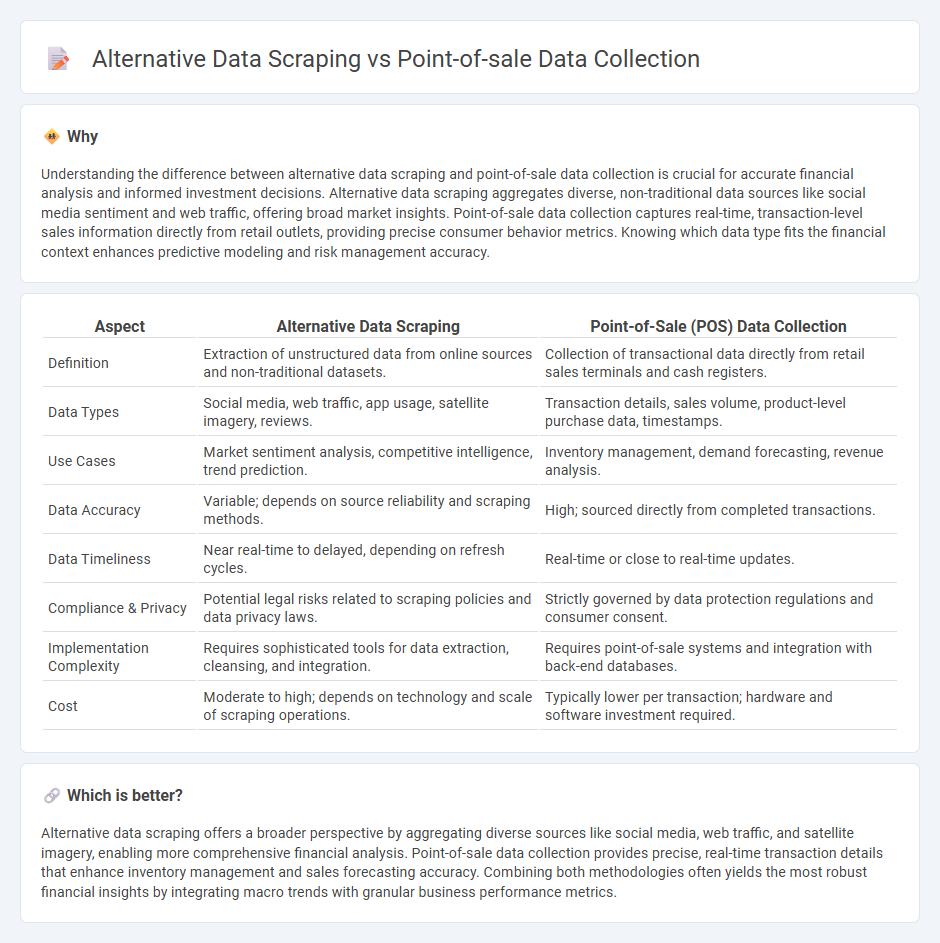
Alternative data scraping involves extracting valuable financial insights from unconventional sources such as social media, web traffic, and satellite imagery, providing a broader perspective on market trends. Point-of-sale data collection captures real-time transactional information directly from retail systems, offering precise consumer behavior and sales metrics. Explore the comparative advantages and applications of these data methods to enhance financial decision-making strategies.
Why it is important
Understanding the difference between alternative data scraping and point-of-sale data collection is crucial for accurate financial analysis and informed investment decisions. Alternative data scraping aggregates diverse, non-traditional data sources like social media sentiment and web traffic, offering broad market insights. Point-of-sale data collection captures real-time, transaction-level sales information directly from retail outlets, providing precise consumer behavior metrics. Knowing which data type fits the financial context enhances predictive modeling and risk management accuracy.
Comparison Table
| Aspect | Alternative Data Scraping | Point-of-Sale (POS) Data Collection |
|---|---|---|
| Definition | Extraction of unstructured data from online sources and non-traditional datasets. | Collection of transactional data directly from retail sales terminals and cash registers. |
| Data Types | Social media, web traffic, app usage, satellite imagery, reviews. | Transaction details, sales volume, product-level purchase data, timestamps. |
| Use Cases | Market sentiment analysis, competitive intelligence, trend prediction. | Inventory management, demand forecasting, revenue analysis. |
| Data Accuracy | Variable; depends on source reliability and scraping methods. | High; sourced directly from completed transactions. |
| Data Timeliness | Near real-time to delayed, depending on refresh cycles. | Real-time or close to real-time updates. |
| Compliance & Privacy | Potential legal risks related to scraping policies and data privacy laws. | Strictly governed by data protection regulations and consumer consent. |
| Implementation Complexity | Requires sophisticated tools for data extraction, cleansing, and integration. | Requires point-of-sale systems and integration with back-end databases. |
| Cost | Moderate to high; depends on technology and scale of scraping operations. | Typically lower per transaction; hardware and software investment required. |
Which is better?
Alternative data scraping offers a broader perspective by aggregating diverse sources like social media, web traffic, and satellite imagery, enabling more comprehensive financial analysis. Point-of-sale data collection provides precise, real-time transaction details that enhance inventory management and sales forecasting accuracy. Combining both methodologies often yields the most robust financial insights by integrating macro trends with granular business performance metrics.
Connection
Alternative data scraping involves extracting non-traditional financial information from various digital sources, which complements point-of-sale (POS) data collection by providing real-time consumer behavior insights beyond standard transaction records. Combining scraped alternative data with POS data enhances predictive analytics for credit risk assessment, market trends, and inventory management in the finance sector. Financial institutions utilize this integrated data approach to refine decision-making processes, optimize lending strategies, and improve revenue forecasting.
Key Terms
Transaction Records
Point-of-sale (POS) data collection captures real-time transaction records directly from retail environments, ensuring high accuracy and granularity in consumer purchase behavior analysis. Alternative data scraping aggregates transaction information from secondary online sources, which may offer broader but less precise insights due to its indirect nature. Explore comprehensive differences and benefits of POS data versus alternative data scraping to enhance your transaction records understanding.
Web Scraping
Point-of-sale data collection captures direct transactional data from retail environments, providing precise consumer purchase information while alternative data scraping, particularly web scraping, extracts vast amounts of unstructured online content such as pricing, product availability, and customer reviews. Web scraping enables real-time market trend analysis by aggregating data from multiple e-commerce platforms and social media channels to uncover competitive insights and consumer behavior patterns. Explore advanced web scraping techniques to harness valuable alternative data for strategic decision-making.
Consumer Behavior Analytics
Point-of-sale data collection captures precise transactional information directly from retail systems, offering real-time insights into consumer purchase patterns and product preferences with high accuracy. Alternative data scraping aggregates diverse online consumer data, such as social media interactions, website visits, and review sentiments, enabling broader behavioral analysis and trend prediction. Explore deeper into how combining these methods enhances consumer behavior analytics for strategic marketing.
Source and External Links
What is POS Data? Meaning, Types, Benefits & How it is Collected - POS data is automatically collected by POS systems at the time of sale, capturing product details, customer information, payment methods, and timestamps, then stored centrally for analysis; data can be collected via barcode/QR scanning and integrated with other systems to enhance business insights.
What is Point of Sale (POS) Data? Uses, Types & Datasets - POS data includes transaction records, payment methods, customer purchasing behavior, sales trends, and inventory data, often enriched with store location and consumer demographics to support retail analytics and decision-making.
Understanding POS Data: Unlocking Insights for Your Business - POS data comprises sales, customer, inventory, and payment data collected via POS software, which can generate detailed reports and analytics to track consumer behavior, sales trends, inventory movement, and employee performance across sales channels.
 dowidth.com
dowidth.com